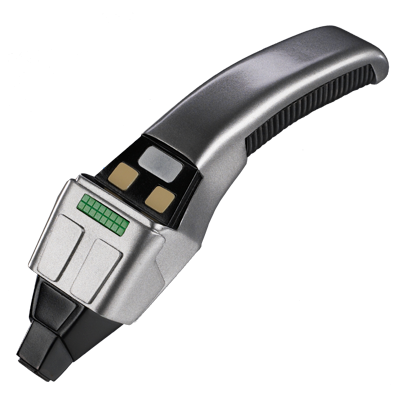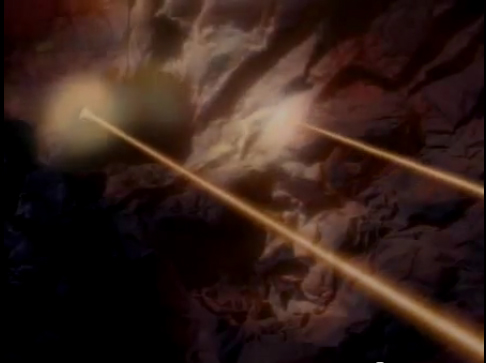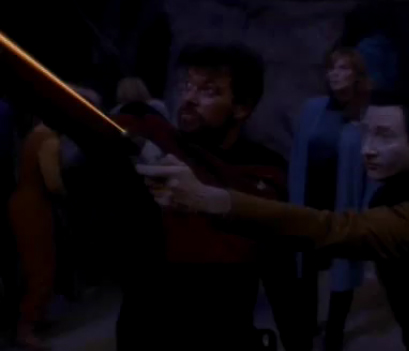


Hand phaser is basic Federation sidearm, and, until Dominion war, was basic weapon of Federation security personell. There are two types of hand phaser - type I, small, "pocket" weapon, and type II, which I will analyze here, and which is shown above.
In TNG episode "Silicon Avatar" we see hand phaser heating between 1 and 4 cubic meters of stones to red glow, over timeframe of 5 seconds..


Before that, we are informed that cave has some kelbonite and fistrium in rock, which itself was probably granite. From this we can conclude that temperature of various parts of rock varies from 480 ° C to 1300-some ° C, with temperature at point of beam impact itself being ~1400 ° C. From distribution of glowth (stones away from beams are colder) we can conclude that it is DET, and not NDF.
Heat capacity of granite is 2.17 J / (cm^3 x K). Volume is, as estimated before, between 1 and 4 million cubic centimeters. Assuming starting temperature of 25 ° C, and average temperature of heated stone as 800 ° C, we have delta t as being 775 ° C. From that, we have low end of 1 681 750 000 J and high end of 6 727 000 000 J (1.7 and 6.7 GJ, respectively). With timeframe of 5 seconds, and divided into two phasers, we have output between 168 and 672.7 MW per phaser.
Hand phaser is mostly used at ranges of several to several tens of meters.
Hand phaser seems to fire continuous beam; however, there is evidence to the contrary (aside from appearance and sound of beam) - Kira describes Cardassian rifle as having 4.7 MJ output, with 3 milisecond recharge time and 2 beam settings (incidentally, that gives it total output of 1.57 GW). However, it definetly fires fast enough for beam to appear coherent.
Hand phaser can also be set to wide beam, affecting multiple targets over certain area.
Only incident from which we can calculate power capacity is, unfortunately, TOS episode "Galileo Seven".
"The Galileo Seven"[TOS1] features the use of phasers drained into a shuttlecraft's engines to enable it to take off and make orbit.
TOS shuttle is 7.44 meters long.
http://www.st-v-sw.net/STSWvolumetrics.html
According to that, Type 6 shuttle weights 29-113 tons. For TOS shuttle, I will assume mass of 48, 188 and 200 tons.
With this calculator we can calculate energy requirements to put shuttlecraft into orbit.
Low Earth orbit is 160 to 2 000 kilometers, but below 200 km objects experience orbital decay. Given that they were concerned with losing orbit after fuel was spent - and did lose orbit - I think it would be safe to assume that they were below 200 km. However, we don't know amount of energy they needed to hold orbit.
So we have this situation:
Mass - minimum energy to reach orbit
48t - 75.264 GJ
188t - 294.784 GJ
200 t - 313.6 GJ
We know five phasors were onboard. That would give us 15 to 60 GJ power capacity.